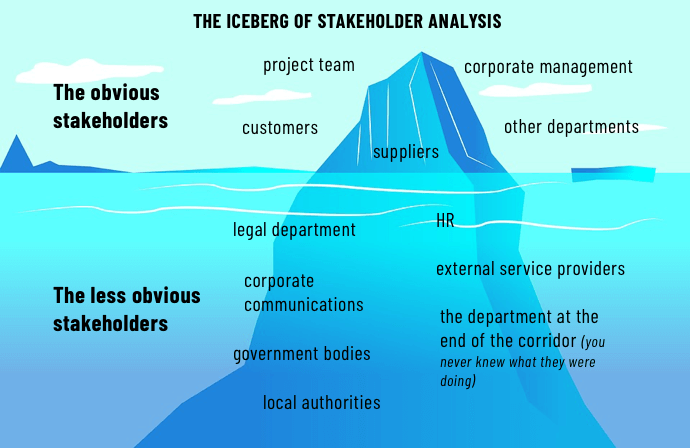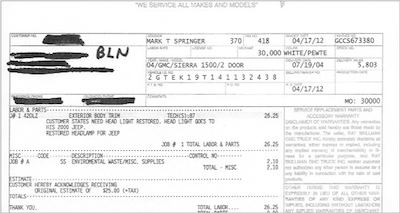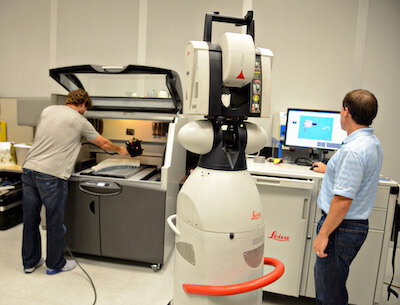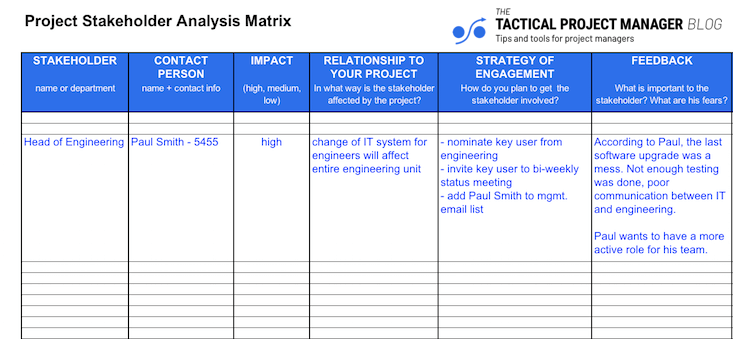Stakeholder analysis is something you should absolutely do. It’ll save you tons of pain and hassle along the road.
In this article I’ll show you how to perform a stakeholder analysis in a project.
But first:
What are stakeholders?
Stakeholders are all the people and organizational units that are somehow affected by a project.
The definition of “affected” is quite broad:
Everyone who’s got an active role in your project naturally is a stakeholder. They are the obvious stakeholders like the project team and all staff contributing to the project.
Then, there are the “less obvious” stakeholders:
People or departments who are going to “feel” the impact of your project. Departments that you would have never thought of. Or suppliers, because the project is having an indirect impact on the purchasing process.
Another important subgroup of stakeholders are those folks who have to approve what you’re doing. Let’s say your project is about building a new manufacturing plant. Sure enough, the construction work will have to get approved by local authorities.
Let’s note:
Stakeholders can be both internal or external.
Here’s an image to visualize what we have to tackle:
The iceberg of stakeholder analysis
Hint: You have to look beyond the surface to identify ALL stakeholders.

Now, the important question:
Why should you try to identify project stakeholders?
Let’s rephrase the question:
What happens if you skip it?
Your project will get in trouble.
In the best case you’ll just have to invest extra time for redoing work and sorting out conflicts. In the worst case, your project won’t even get across the finish line.
Not knowing your stakeholders can lead to BAD consequences:
- Your project will fail to meet all necessary requirements
- Your project is put on hold, just because some late-to-join stakeholder now sets the pace
- You have to ask for extra project budget due to unforeseen scope changes (good luck!)
- Your project may violate company policies or legal regulations
Do you need more convining as why stakeholder analysis should be done thoroughly?
Personally, I invest several days into digging deep and identifying every potential stakeholder.
The process for identifying stakeholders: performing a stakeholder analysis
Identifying stakeholders isn’t just a task you do and then forget. It’s more about being vigilant, like a hunter on the prawl. Just without the shooting, please …
The way I do the analysis is by looking at processes, people and things.
What processes are affected?
Processes are the workflows within an organization to get work done. There’s a process for buying goods, a process for shipping goods to the customer, a process for hiring new employees etc. Companies have defined processes for everything.

Processes are great for stakeholder analysis. You can see how a change in one area (e.g. engineering) has repercussions on another department (e.g. manufacturing).
Example: Let’s say you are running an engineering project for the redesign of your company’s product. Then you’ll have to talk to the manufacturing guys. They will eventually manufacture the goods.
So, how can you find out about the processes?
By talking to people and asking good questions:
- Could you describe to me your current process for <TOPIC>?
- What other departments do you work with?
- Whom do you send the files/documents/notes to?
- Who provides you with these files/documents/notes?
- What do you do once your part is done?
I think you get the idea.
The point of these questions is to get a sense of how things are MOVING inside an organization: Information, data, products, people etc.
Knowing the processes is only the first step.
Your next step is to identify the:
- people you need to involve (because your project influences their work)
- things you need to look at
What people are affected?
Once you know the relevant processes, getting to the people level is easy.
In our engineering project example, we know that we have to involve engineers and production managers at our company. That’s an insight we gained from the process analysis.
There are also specific questions you can ask:
- Who is using this system/software/product/area?
- Who else do we need to talk to?
- Do we require approval from anybody for this?
The last question is a very important one. Most processes, tools or products are owned by somebody. Owning in the sense that they have a saying about how a process, tool or product should be designed.
Examples:
- The purchasing process is owned by the head of purchasing
- The IT system is owned by the head of IT
- The product your company manufactures is owned by the head of the business unit.
These owners must absolutely be involved in the project. You simply won’t be able to accomplish anything without their approval. They are your stakeholders.
Project management tip:
There’s another perspective I recommend you include in your stakeholder analysis: People’s attitude towards the project. In general, do they support the project? Or do they have any objections? Make notes of the impression you get by talking to the stakeholders.
For instance, if you find out that:
“The head of manufacturing is worried that we don’t dedicate enough time on the training of his team. He’s concerned we’ll face production issues due to poor training.”
That’s an important insight.
Make a note in your to-do list to organize training for the manufacturing team.
Looking at things to gain insights about stakeholders
Adrian, what do you mean here?
This is a more advanced strategy for finding relevant stakeholders.
It’s based on the following insight: Very often, people are not able to name all the people or departments they have a relationship with. Why?
- Reason 1: They just don’t know.
- Reason 2: The relationship is somewhat hidden. Example: When shutting down the server of your department, you forget that it is also used by a few users of another department.
In these situations asking around won’t give you any further information.
You have to have a closer look at things, such as:
- tools or products used
- documents received or shared
- files and other data shared between departments.
Here’s a tangible example to make it clear:
Analyzing documents to reveal potential stakeholders
Suppose you’re heading an IT project. As part of the project, your team has to ensure that invoices can be printed from the new system just as before. What you do is have someone in your team look at every field on the document and ask: Where’s this information coming from?

For example, you might learn that the product weight value on the invoice is coming from another IT system, which is managed by a different team. A new stakeholder you need to involve! Or you might find out that the invoice layout has to be approved by your company’s tax counselor. That’s another important stakeholder to have on your project.
Analyzing other items to reveal potential stakeholders
“Who’s in charge of maintaining this printer?”, “Who can reconfigure this machine for us?”. Take a look at the tools, machines and other items used within your project. And find out who else you need to get on board.

I have identified the key stakeholders. What should I do next?
Ok, great.
Here’s what I recommend you do:
First, make the stakeholders you’ve identified an official partner of the project. Assign them a project role, such as coordinator for manufacturing processes or key-user manufacturing. (read more about project roles here)
A project role naturally requires effort. So, you need to estimate the person’s effort for the duration of the project. As an example, we’ll estimate the manufacturing coordinator’s effort at 2 days per week from now til project closure.
Second, invite the stakeholders to relevant meetings and add them to your project communication plan. Schedule additional meetings if necessary.
Project management tip:
Getting something approved fast is crucial to avoid project delays. For stakeholders with an approver role in your project, schedule approval meetings right from the start.
My BEST advice I can give you about handling stakeholders:
Talk to project stakeholders on a regular basis. Not just within the official meetings. Invite them for coffee breaks. Join them during lunch in the canteen. Listen to what they have to say. Answer their questions and respond to their concerns.
By speaking to your stakeholders regularly you’ll always get the latest news. This will allow you to make good decisions and to spot issues early on (before they become a fire).
Here’s my stakeholder analysis template
Use the below Excel template to record the findings from your analysis.

Download the stakeholder analysis template (XLS)
Author
-
Hi, I’m Adrian, a Senior Project Manager and the Creator of Tactical Project Manager, where I teach a pragmatic approach to project management. Led large-scale IT and business projects for over 10 years. My goal is to enable you to lead any project with confidence.
View all posts



